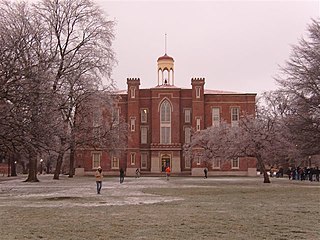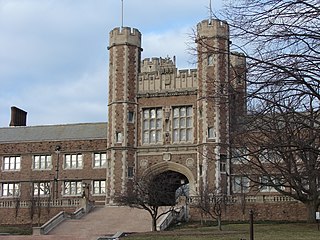
Xavier University of Louisiana is a private, historically black, Roman Catholic university in New Orleans, Louisiana. It is the only Catholic HBCU and, upon the canonization of Katharine Drexel in 2000, became the first Catholic university founded by a saint.

Katharine Drexel was an American heiress, philanthropist, religious sister, educator, and founder. She was canonized by the Roman Catholic Church in 2000; her feast day is celebrated on March 3. She was the second American to be canonized a saint and the first one born a U.S. citizen. She was inducted into the National Women's Hall of Fame in 2011.

The Louisiana State Capitol is the seat of government for the U.S. state of Louisiana and is located in downtown Baton Rouge. The capitol houses the chambers for the Louisiana State Legislature, made up of the House of Representatives and the Senate, as well as the office of the Governor of Louisiana. At 450 feet (137 m) tall and with 34 stories, it is the tallest building in Baton Rouge, the seventh tallest building in Louisiana, and tallest capitol in the United States. It is located on a 27-acre (110,000 m2) tract, which includes the capitol gardens. The Louisiana State Capitol is often thought of as "Huey Long's monument" due to the influence of the former Governor and U.S. Senator in getting the capitol built. The building's construction was completed in 1931. It was listed on the National Register of Historic Places in 1978 and was designated a National Historic Landmark in 1982.

Uptown is a section of New Orleans, Louisiana, United States, on the east bank of the Mississippi River, encompassing a number of neighborhoods between the French Quarter and the Jefferson Parish line. It remains an area of mixed residential and small commercial properties, with a wealth of 19th-century architecture. It includes part or all of Uptown New Orleans Historic District, which is listed on the National Register of Historic Places.

Gallier Hall is a historic building on St. Charles Avenue in New Orleans, Louisiana. It is the former New Orleans city hall, and continues in civic use. Built 1845–1853, it is a nationally significant example of Greek Revival architecture, and one of the finest works of architect James Gallier. It was designated a National Historic Landmark in 1974.

The Old Louisiana State Capitol, also known as the State House, is a historic government building, and now a museum, at 100 North Boulevard in Baton Rouge, Louisiana, U.S.A.. It housed the Louisiana State Legislature from the mid-19th century until the current capitol tower building was constructed in 1929-32.

National American Bank Building is a 23-story 325 feet (99 m)-tall skyscraper in the Central Business District of New Orleans, Louisiana, It was completed in 1929 and listed on the National Register of Historic Places in 1986. It is topped with a distinctive 6-story octagonal tower with a golden Art Deco finial. Its address is 200 Carondelet Street. Originally a commercial building it was renovated for use as a residential building after Hurricane Katrina.

The Presbytère is an architecturally important building in the French Quarter of New Orleans, Louisiana. It stands facing Jackson Square, adjacent to the St. Louis Cathedral. Built in 1791 as a matching structure for the Cabildo, which flanks the cathedral on the other side, it is one of the nation's best examples of formal colonial Spanish architecture. It was designated a National Historic Landmark in 1970, and is now a property of the Louisiana State Museum.
Main Building is a common name for a building on some university and college campuses serving as home to administrative offices, such as president or provost and may refer to:

Old Main is the oldest building on the campus of Knox College in Galesburg, Illinois. Completed in 1857, it is a distinctive Gothic Tudor design of Swedish architect Charles Ulricson. It was designated a National Historic Landmark in 1961 as one of the few surviving sites to host one of the famous 1858 Lincoln–Douglas debates. The building underwent a major restoration in the 1930s, which modernized its interior and restored its exterior.

Louisiana State Bank Building is a historic commercial building at Royal and Conti Streets in the French Quarter of New Orleans, Louisiana. Built in 1820, it was the last structure designed by nationally prominent architect Benjamin Henry Latrobe, who died from yellow fever in New Orleans before its construction. It has also been known as the Manheim Galleries building, from a long-time tenant. More recently, it has housed "Latrobe's", an event venue. It was declared a National Historic Landmark in 1983.

Ursuline Convent was a series of historic Ursuline convents in New Orleans, Louisiana. In 1726, nuns from the Ursuline Convent of Rouen (Normandy) went to New Orleans to found a convent, run a hospital, and take care of educating young girls.

The Washington University Hilltop Campus Historic District was the site of the 1904 Louisiana Purchase Exposition and the 1904 Summer Olympics. Many of the exposition buildings were temporary in nature, but a number of permanent structures were built and are used by Washington University, which calls this area the Danforth Campus. The district includes more than fifty structures, of which twenty are in the Collegiate Gothic style.

St. Elizabeth's Convent is a historic Roman Catholic convent located at 1663 Bristol Pike in Cornwells Heights, Bensalem Township, Bucks County, Pennsylvania. From 1892 to 2017 it served as the motherhouse of the Sisters of the Blessed Sacrament, founded by St. Katharine Drexel as the Sisters of the Blessed Sacrament for Indians and Colored People.

Gethsemane Lutheran Church is a historic Lutheran church in downtown Austin, Texas. Designated as a Recorded Texas Historic Landmark and listed on the National Register of Historic Places, the building currently holds offices of the Texas Historical Commission.

The History of Louisiana Tech University began when the Industrial Institute and College of Louisiana was founded in Ruston, Louisiana in 1894. The institute was founded to develop an industrial economy in the state of Louisiana. Four years later, the school was renamed the Louisiana Industrial Institute when Louisiana adopted the Constitution of 1898. When the Constitution of 1921 was passed, the school changed its name again to Louisiana Polytechnic Institute to reflect the school's evolution from a trade school into a larger and broader technical institute. Although the university was informally called Louisiana Tech for about five decades after the 1921 name change, it was not until 1970 when Louisiana Polytechnic Institute officially changed its name to Louisiana Tech University. Over the course of its history, the school grew from a small industrial institute with one building to a university with five colleges and an enrollment of around 11,800 students.

Holy Cross Church and Convent is a Roman Catholic church complex in Green Bay, Wisconsin, with six structures built from 1862 to 1932 in various architectural styles. Currently, it is also a church school. The complex was added to the National Register of Historic Places on June 28, 2001 for its architectural significance.
St. Katharine Drexel Preparatory School is a private, Roman Catholic high school in New Orleans, Louisiana. It is located in the Roman Catholic Archdiocese of New Orleans. The school replaced Xavier University Preparatory School, which closed the same year.

The Hugh Roy and Lillie Cullen Building is the central administration building of Southwestern University in Georgetown, Texas. Completed in 1900, the Cullen Building was declared a Recorded Texas Historic Landmark in 1962 and has been listed on the National Register of Historic Places since 1975, together with neighboring Mood-Bridwell Hall.

The Little Campus is a historic district and part of the University of Texas at Austin campus in Austin, Texas. Originally built in 1856 as the Texas Asylum for the Blind, the complex was used for a variety of purposes through the late nineteenth and early twentieth centuries. It was acquired by the University of Texas after World War I and listed on the National Register of Historic Places in 1974.




















